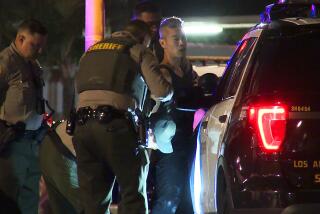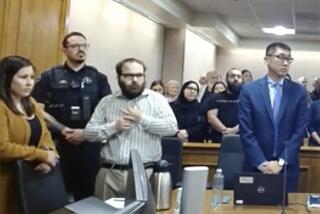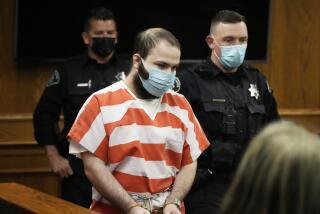Washington Navy Yard shooter Aaron Alexis heard voices
WASHINGTON — Six weeks ago, Aaron Alexis told people someone had threatened him at an airport in Virginia. A few days later, in Rhode Island, he heard voices. He thought people were speaking to him through “the walls, floor and ceiling” of the Navy base there, where he was working.
In his hotel room, the voices used “some sort of microwave machine” to send vibrations through the ceiling and into his body, a police report shows him saying. He could not sleep.
FOR THE RECORD:
This article wrongly provides a full name in place of an acronym in a quotation from the lawyer for the Sharpshooters Small Arms Range and gun store in Lorton, Va. Attorney J. Michael Slocum said the store had provided Aaron Alexis’ information to the NICS, the National Instant Criminal Background Check System, not the federal Naval Criminal Investigative Service.
Alexis frequently moved as part of his contract work at military installations from New England to North Carolina; he arrived in Washington on Aug. 25. He switched hotels several times until Sept. 7, when he finally settled into the Residence Inn — a mile from his new workplace at the historic Washington Navy Yard on the capital’s waterfront.
On Saturday he visited a gun shop in the Virginia suburbs. He practiced firing a rifle, then purchased a Remington 870 shotgun and 24 shells. The short-barrel weapon, known popularly as a “riot gun,” is commonly used by police and the military.
WHO THEY WERE: Navy Yard shooting victims
On Monday he reported to work with that shotgun. The FBI says he had a valid pass to enter the base. At 8:15 a.m., in Building 197, the most crowded structure there, he opened fire, grabbed a pistol along the way, and killed 12 people, shooting at police until they killed him in a gun battle that lasted about half an hour.
A day later, Alexis’ history of mental problems, his extensive disciplinary record from his time in the Navy, and his three arrests over the last decade — two of them for gun-related incidents — have generated numerous questions.
Many are reminiscent of past mass shootings: How had police, the military and the company he worked for missed the accumulating signs of trouble? Why was the 34-year-old loner and drifter given an ID card that would allow him to easily come and go from military bases around the country without a security check? How could he so readily pass a background check to buy a shotgun?
Amid those questions, Defense Secretary Chuck Hagel plans to order a review of security procedures at all Defense Department installations in the U.S., a Pentagon official said Tuesday.
At the company Alexis worked for, the Experts, an information technology firm based in Ft. Lauderdale, Fla., Chief Executive Thomas E. Hoshko said that despite having paid another company to conduct a background check on Alexis before hiring him in 2012, to Hoshko’s knowledge his company was “never made aware of any criminal or health issues.”
“I have more questions than you, and I am working to find out what can be done to improve security on bases, as well as the security process,” he wrote in an email.
Alexis’ secret-level security clearance, which he originally received in 2008 after joining the Navy, made him a valuable hire for an IT company with contracts to work on classified computer networks. And it allowed him entry to the Navy Yard without being searched.
PHOTOS: The Navy Yard shooting
Like most military personnel, Alexis got his clearance as a routine matter so he could access the computers that he might use on a daily basis in his job as an electronics expert on C-40 cargo planes at Fort Worth Naval Air Station, Navy officials said.
The clearance was good for a decade, officials said. Although his Navy record included several unauthorized absences from duty, instances of insubordination and disorderly conduct, one case of being absent without leave and several failed inspections, none of the problems rose to a level that would have jeopardized his clearance, they said.
When Alexis was discharged in 2011, his clearance became inactive, but it was reinstated without the need for additional investigation when he went to work for a contractor, officials said.
“The security clearance system is not foolproof,” said Steven Aftergood, a secrecy and security expert with the Federation of American Scientists. “But what is reasonable to expect is that evidence of past criminal activity and a propensity to violence should be detected, and in this case the process failed to do that.”
Navy officials said that because of his disciplinary problems as a sailor, they had considered giving Alexis something less than an honorable discharge. But since he had never been convicted of a crime and had glowing fitness reports, they eventually granted him an honorable separation.
In evaluations from 2007 to 2011, first reported by Fox News, Alexis was described as “an eager trainee” with “unlimited potential” and a “get-it-done attitude.” A 2008 report called him a “talented technician” on aircraft electrical systems who should be promoted.
An arrest in Georgia in 2008 for disorderly conduct stemming from an incident at a bar, however, prompted a negative review.
“He has had a severe lapse in judgment on a number of occasions and has been counseled several times for inappropriate conduct,” the review said in spring 2009, noting that he had been reduced in rank and had his pay docked.
FULL COVERAGE: Navy Yard shooting
When Alexis appealed the punishment, it was overturned. Subsequent reviews were once again positive.
The system of background checks for gun purchases also failed to pick up Alexis’ problems.
J. Michael Slocum, an attorney for the Sharpshooters Small Arms Range and gun store in Lorton, Va., said that “Mr. Alexis’ name and other applicable information, including his state of residency, was provided to the federal [Naval Criminal Investigative Service] system, and he was approved by that system.”
The shotgun purchase appears to have complied with Virginia’s laws, which are less stringent than those in some other states. In 2007, after 23-year-old student Seung-hui Cho killed 32 students and faculty members at Virginia Tech, then-Gov. Tim Kaine signed an executive order requiring that the names of all people involuntarily committed to mental health facilities be provided to a federal database that licensed gun dealers are supposed to check before they sell anyone a gun.
But Alexis does not appear to have been committed. In Rhode Island, when he reported hearing voices, police told him to stay away from the people he thought were bothering him, but otherwise took no action, according to a police report released Tuesday. Rhode Island, like most other states, sets a fairly stringent standard for what officials must prove in order to involuntarily commit a person.
As a result, when Alexis reported to the Navy Yard, he “had legitimate access … as a result of his work as a contractor, and he utilized a valid pass to gain entry to the building,” Valerie Parlave, assistant director in charge of the FBI’s Washington field office, said at a news conference Tuesday.
Security at the base already has been reviewed. A Defense Department inspector general’s report released Tuesday said that a computer database system the Navy had adopted to reduce costs while controlling contractors’ access had allowed convicted felons onto bases 52 times.
Several members of Congress quickly leapt on the report, saying it pointed to problems. “This apparent security lapse — permitting people with criminal records to freely access military bases and facilities — is deeply troubling,” said Sen. Richard Blumenthal (D-Conn.), a member of the Armed Services Committee.
Alexis arrived at the base with the shotgun, and “may have gained access to a handgun once inside the facility and after he began shooting,” Parlave said. Investigators believe he may have shot and killed a security guard and taken his weapon. Contrary to previous accounts that were widely reported Monday, Parlave said Alexis had not used an AR-15 semiautomatic rifle.
Cathy Lanier, chief of Washington’s Metropolitan Police Department, said police officers were at the Navy Yard within two minutes of the first calls for help. Within four or five minutes, she said, seven police units were on the scene, trying to determine where the gunfire was coming from.
“There were different buildings, different calls and different building numbers,” she said. After a short time, she said, “we had units outside the building where the shooter was, and they could hear another round of gunfire. They entered immediately and two of them started giving lookouts and passing information along.
“There were multiple engagements with the suspect with multiple agencies before the final shots were fired,” and this “saved numerous lives,” Lanier said.
Parlave said the FBI believed Alexis acted alone. Ronald C. Machen Jr., U.S. attorney in Washington, said federal prosecutors nonetheless were investigating whether others assisted him in any way, even inadvertently. “We’re not going to stop until we get answers to these questions,” he said.
Melinda Downs, 44, a close friend from Alexis’ days in Fort Worth, said she wished someone had helped him in other ways. Although he stayed with her and her husband during part of August, Downs said she had no clue that he had been hearing voices while in Rhode Island. She said he did not mention being followed or frequently changing hotels, nor his previous arrests for firing a gun through the ceiling of his apartment in Fort Worth and shooting the tires of a person’s car in Seattle.
But, Downs said, she wished police had done more when he called them in distress.
“Did they try to get him some kind of help?” she wondered. “Take him to a counseling center?”
“When someone calls in with this type of mental instability, and you do nothing and yet he has access to all these weapons — the police who took that call have some kind of accountability,” she said. “Why didn’t they get him help?”
Serrano and Cloud reported from Washington and Hennessy-Fiske from Fort Worth. Times staff writers Tina Susman in New York and Richard Winton in Los Angeles contributed to this report.
More to Read
Sign up for Essential California
The most important California stories and recommendations in your inbox every morning.
You may occasionally receive promotional content from the Los Angeles Times.












